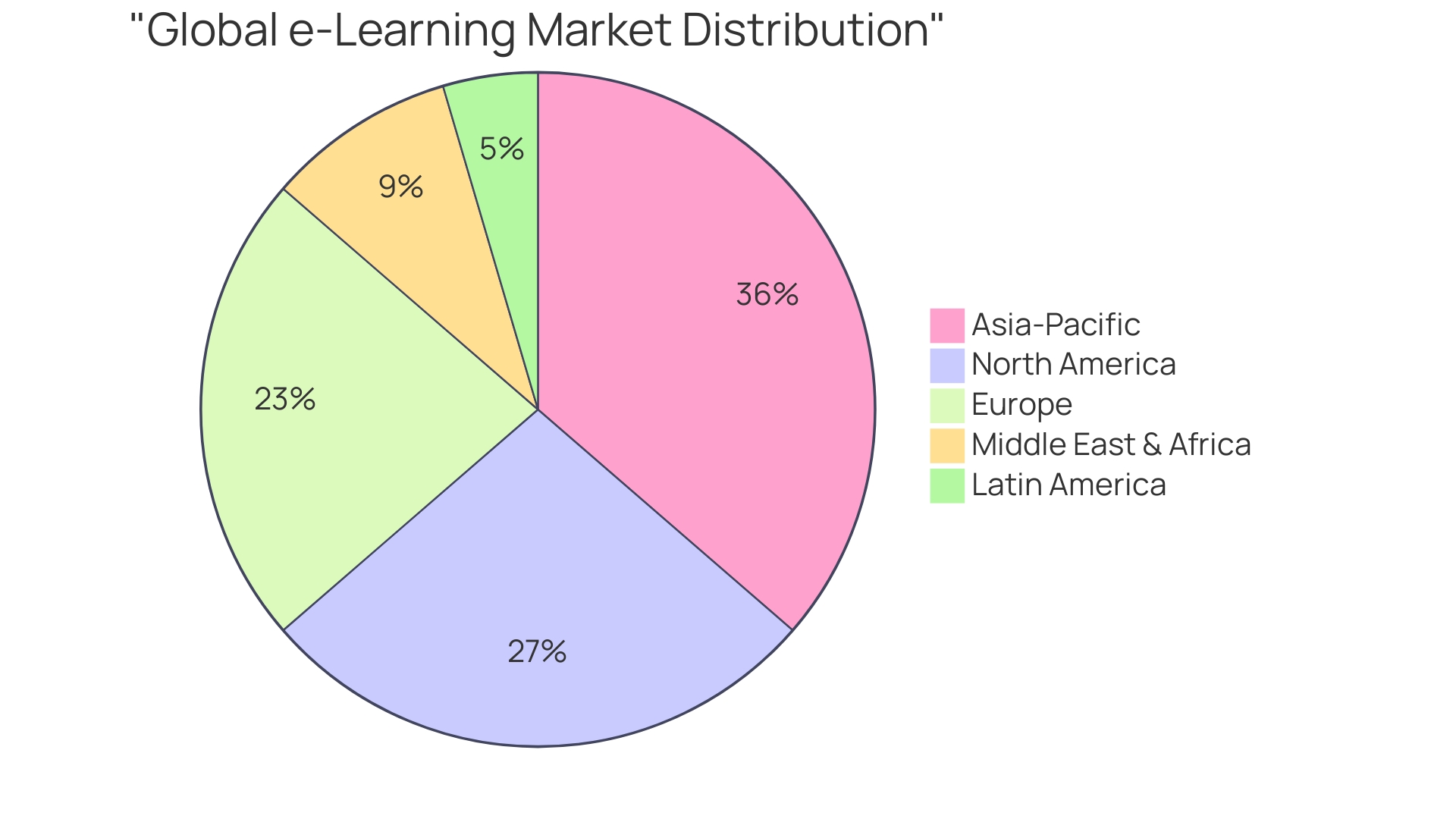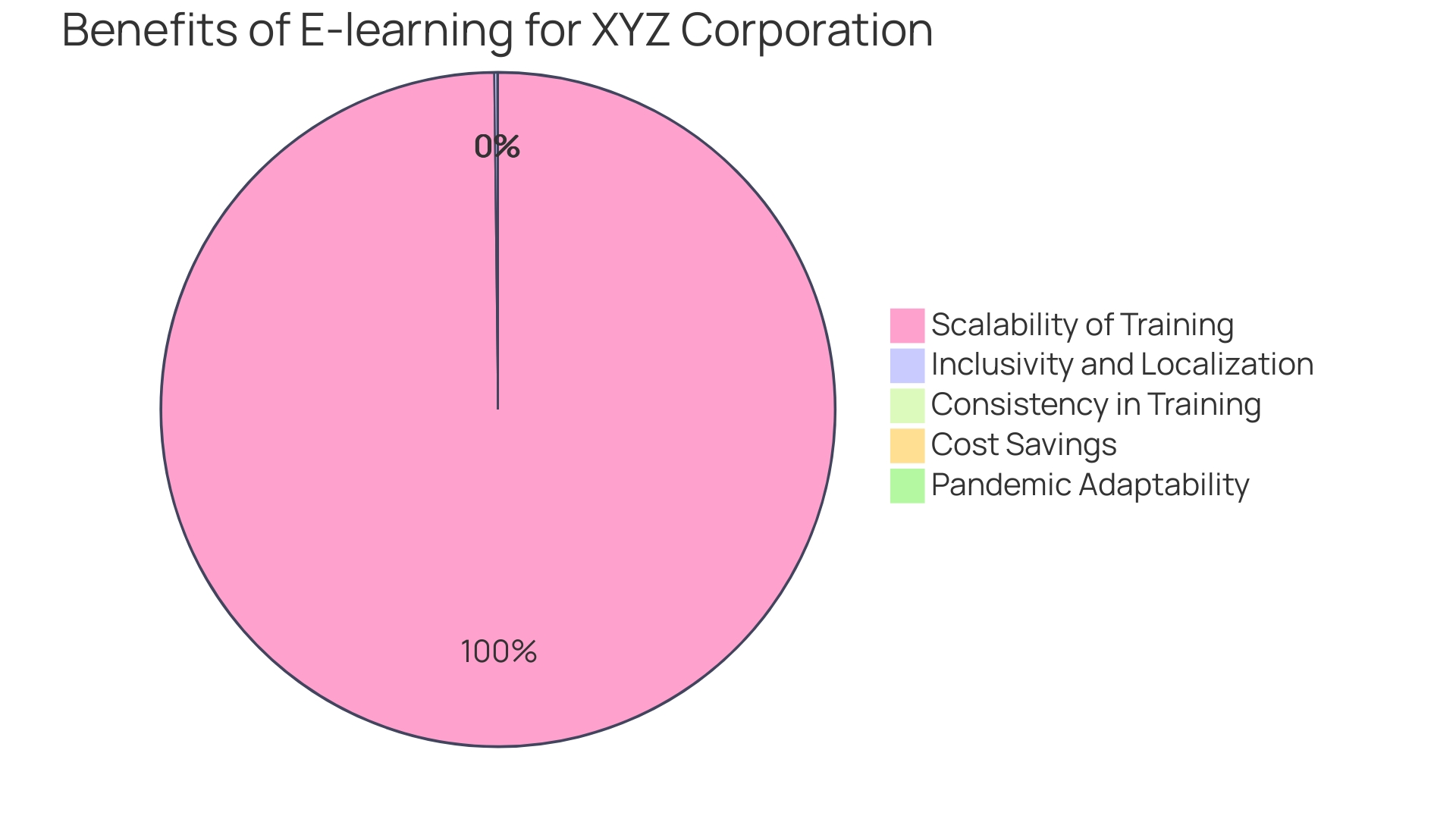Introduction
E-learning has become a pivotal force in education, reshaping how we learn and grow. From simple text-based instruction to immersive multimedia experiences, the evolution of e-learning has transformed the learning landscape.
In this article, we will explore the innovations, best practices, and real-world case studies that demonstrate the power and effectiveness of e-learning development. With projections estimating the e-learning market to reach a staggering $661.6 billion by 2032, it is clear that e-learning is here to stay. Join us as we dive into the exciting world of e-learning and discover how it is revolutionizing education.
The Evolution of E-learning Development
E-learning is not just a trend; it's a pivotal force in the educational landscape, reshaping how we learn and grow. The evolution from simple text-based instruction to immersive, multimedia-rich experiences is a testament to this.
Take the example of LEDVANCE, a global leader in lighting. They've demonstrated that even the most intricate of subjects can be effectively communicated through eLearning.
By integrating interactive elements like simulations and animations, they've made learning about complex lighting systems and smart technologies both comprehensive and engaging. Case studies, a staple of eLearning, can sometimes lack emotional impact.
But by weaving these studies into a narrative complete with characters and plots, or by using interactive timelines, the learning experience becomes not only more captivating but also more memorable. It's a fine balance between the theoretical and the practical, as Learning Pool's custom content services show, blending online and physical training for maximum effectiveness.
The importance of eLearning has been underscored by its resilience during times of crisis. Its benefits of accessibility and flexibility are unmatched, allowing people to learn from anywhere, at any time.
This has proven essential for both personal advancement and professional development. As a result, the eLearning market is poised for significant growth, with projections estimating it to reach a staggering $661.6 billion by 2032. As the eLearning landscape advances, it's crucial for educators to fully leverage technology. This means not only embracing tools like AI and AR for a more tailored and interactive learning journey but also preparing learners with critical soft skills for the modern workforce. With mobile learning alone expected to grow by 17.9% and reach $77.4 billion by 2025, the trajectory of eLearning is clear. It's an exciting time for both learners and educators as we navigate this digital education revolution.
Innovations in E-learning Development
The digital transformation of education is gaining momentum, with virtual reality (VR) and augmented reality (AR) at the forefront, offering novel ways to engage learners. For instance, VR can simulate complex environments for immersive, hands-on experiences.
A study by PwC highlights VR's effectiveness, noting a 40% increase in learner confidence and a 35% improvement in the application of skills post-training compared to traditional methods. Furthermore, VR has reached cost parity with classroom learning at scale, underscoring its economic viability.
AR complements VR by overlaying digital elements onto the real world, enriching the learning context. This synergy of technologies is exemplified by Learning Pool's blended program, which reduced in-store management training from one day to two hours of online content, without compromising effectiveness.
The program's success, confirmed by a pilot evaluation, demonstrates the transformative potential of integrating AR and VR into eLearning, enhancing both engagement and efficiency. The global eLearning market is poised for significant growth, projected to reach US$ 661.6 billion by 2032, with a CAGR of 8.6% from 2023 to 2032. This growth is fueled by the demand for remote learning, which offers accessibility, flexibility, and cost-effectiveness. As eLearning evolves, augmented by technologies like VR and AR, it becomes a more dynamic and interactive experience, shaping the future of education across the globe.
Best Practices for Effective E-learning Development
Crafting compelling e-learning content is paramount in today's rapidly evolving educational landscape. To captivate and educate, content must resonate with learners on a personal level, catering to their unique learning styles and cognitive preferences. Incorporating interactive elements is not merely a suggestion but a necessity to stimulate engagement and motivation.
A balanced integration of multimedia enhances the learning journey, aiding retention without distracting from core objectives. Strategically placed assessments and feedback mechanisms are crucial for monitoring progress and providing tailored support. A prime example of these principles in action is Learning Pool's blended program for Lidl GB, which adeptly combines online learning with practical activities, significantly reducing training time while maintaining efficacy.
In the realm of e-learning, the global market is on an upward trajectory, with projections reaching a staggering $661.6 billion by 2032, propelled by the alluring benefits of remote learning, such as accessibility and cost-effectiveness. A globalized educational reach demands e-learning solutions that transcend geographical barriers, offering standardized, culturally adaptable content to an international audience. Furthermore, with approximately 4.6 million college students in the United States enrolled in online courses, the significance of e-learning is unmistakable.
The anticipated growth of the Learning Management System market to over $25.7 billion by 2025 underscores the sector's expansion. Educators' attitudes towards personalized learning vary, yet a substantial number recognize its transformative potential. As we navigate this digital era, we must remain vigilant in our pursuit of creating learning experiences that are not only memorable but foster a demonstrable change in learners, going beyond passive content consumption to active, meaningful engagement.

Case Study: Revolutionizing E-learning Development
LEDVANCE showcases an exemplary case in e-learning development, transforming the way technical knowledge and product training are disseminated within the lighting industry. By designing comprehensive online courses, LEDVANCE has made complex topics like smart home technologies and dynamic lighting solutions accessible and understandable to a broad audience, including employees, customers, and end-users. Their commitment to innovation is reflected not only in their product portfolio but also in their approach to education and training.
In a similar vein, Learning Pool's blended program for Lidl GB demonstrates the effectiveness of combining online learning with practical, in-store activities. By integrating Learning Pool’s online modules with real-world experiences, new managers can seamlessly transition into their roles, highlighting the impact of e-learning on operational efficiency and learner engagement. This synergy between hands-on practice and virtual learning environments exemplifies the modern approach to corporate training.
Moreover, the healthcare industry's pivot towards e-learning systems underscores the critical need for up-to-date training in a field characterized by constant evolution. By moving to an in-house eLearning system, healthcare organizations can ensure that their staff remains proficient in the latest medical practices, thereby enhancing patient care and safety. These cases illustrate the transformative power of e-learning across various sectors.
With Gen Z and millennials soon to comprise over half of the global workforce, the demand for dynamic and engaging e-learning solutions is greater than ever. The statistics further cement this narrative, with a staggering 900% increase in online learning since 2000 and companies witnessing an 18% surge in employee engagement through e-learning technologies. As the e-Learning market continues to grow, reaching a projected $77.4 billion by 2025, the imperative for innovative and effective digital learning experiences becomes increasingly clear.
Impact and Results
At XYZ Corporation, the strategic implementation of e-learning development revolutionized their training paradigm. Sales associates, equipped with enhanced product knowledge, were able to elevate sales figures and amplify customer satisfaction.
The company's shift to virtual training sessions, tailored by Learning Pool to include a blend of online learning and practical activities, marked a substantial reduction in travel and training costs. This adaptive approach, complemented by a custom-built Learning Management System (LMS) from eWyse, addressed the multilingual and diverse needs of a global workforce, reflecting a surge in employee engagement by 18%.
The digital transformation in training, necessitated by the halt of in-person sessions during the COVID-19 pandemic, was seamlessly managed by LEDVANCE's partnership with eyes. This transition to online product training, accommodating around 500 courses in over 15 languages, underscores the critical role of tailored e-learning solutions in maintaining up-to-date information across a widespread audience.
With Web3's advent, e-learning is set to undergo a further metamorphosis, leveraging decentralized and transparent technologies to create personalized learning experiences. This evolution, from the initial stages of the internet to the burgeoning era of Web3, is poised to redefine educational engagement, making it a transformative journey rather than a mere transfer of knowledge. The data speaks volumes about the trajectory of e-learning: a projected global LMS market value of over $25.7 billion by 2025 and a historical snapshot where 4.6 million U.S. college students were enrolled in online courses in 2008. These statistics not only highlight the escalating preference for digital learning but also the potential for substantial growth in the e-learning sector. The case of XYZ Corporation exemplifies the transformative power of innovative e-learning development in reshaping traditional training frameworks and propelling forward business outcomes.

Conclusion
In conclusion, e-learning has revolutionized education, reshaping how we learn and grow. Real-world case studies demonstrate its effectiveness in communicating complex subjects and creating engaging experiences. The projected market value of $661.6 billion by 2032 highlights its significant growth potential.
Innovations like VR and AR provide immersive and interactive learning experiences, boosting learner confidence and skill application. Compelling content, interactive elements, and strategic assessments are crucial for effective e-learning development. Case studies across sectors showcase the transformative power of e-learning, from lighting industry training to corporate management programs.
Healthcare organizations also embrace e-learning for staff proficiency in evolving medical practices. E-learning's impact is evident in improved sales, customer satisfaction, reduced costs, and increased employee engagement. With a projected market value of $77.4 billion by 2025, innovative digital learning experiences are essential for meeting the demands of Gen Z and millennials in the workforce.
In summary, e-learning development has revolutionized education through accessible and engaging experiences. Its trajectory toward further growth is fueled by technological innovations and the demand for remote learning. Creating meaningful engagement through personalized experiences remains paramount for educators worldwide in this digital era.





